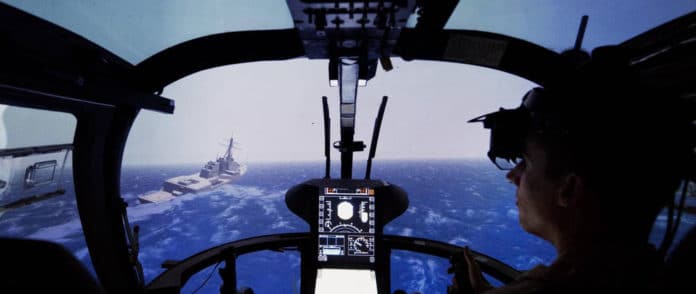Scientists at the Technical University of Munich (TUM) have developed an assistance system that helps helicopter pilots land safely on ships in poor visibility. The system displays critical information in the visor of the pilot’s helmet-mounted display. This helps helicopter pilots in precise landing.
In antagonistic climate conditions, while arriving on platforms such as the deck, the ship heaves, pitches, the helicopter must keep up a safe distance from the superstructures on the upper level to dodge contact with the helicopter’s rotor blades. The helicopter additionally should be far enough from the edge of the deck to maintain a strategic distance from the overhanging fuselage, pulling it in backwards into the sea. In such cases, pilots need to make repeated attempts at the arrival maneuver.
Scientists at TUM have modeled this challenging and dangerous situation using the helicopter simulator at the Chair of Helicopter Technology.
Tim Mehling, a doctoral candidate at the Institute of Helicopter Technology, said, “On the open seas, there are generally few points of visual reference to guide pilots. Pilots are therefore frequently forced to switch their focus from their landing target – the ship’s deck – to glance at the cockpit instrument panel.”
“On top of that, even the best pilot’s concentration will slip after the 20th approach attempt. His idea was to create a helmet-mounted, real-time display that presents all relevant information from the helicopter and the ship – using graphics that are superimposed on the pilot’s view outside the cockpit. This technology is known as augmented reality, or AR for short.”
Scientists primarily developed a highly realistic simulation of the environment at sea. They also considered what information pilots need for a safe approach.
In their system, scientists developed appropriate icons for every phase of the landing. The coordinated icons will automatically appear on the visor during the corresponding flight phase.
The helmet shows a visual attitude marker just as key helicopter parameters. The software can likewise utilize imaging data to consequently identify the ship’s deck and picture the perfect methodology, which resembles a kind of 3D “slide” in the display.
Mehling said, “If visibility is lacking due to bad weather, the pilot can glide down this stable virtual slide to make a safe landing.”
Four test pilots with experience in seaborne operations with the German military and in the private sector have tested the pilot assistance system and given it the thumbs-up. In the next stage of development, it will be tested by pilots working in a wide range of flight ops scenarios. The results will then be used for further optimizations of the system.
